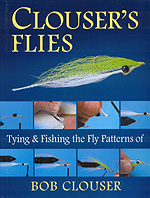I wanted to tie a Carrie Stevens, Rangerly style New England streamer, but was surprised how hard it actually was
I have written an article on the Mickey Finn streamer, and got the bright idea that I would tie a NE style streamer as one of the variations for the article.
How hard can it be?
I have plenty yellow and red feathers and bucktail, tonnes of large, long shank streamer hooks from Partridge and reasonable tying skills.
So into the project I dived, and got through the ribbed tinsel body and bucktail underwing and false hackle with little effort. So now was the time for the wing - or the sides, as it is more like on these streamers. The feathers for the wing are tied in in two bunches, a bunch on each side of the fly, riding vertical and parallel to the hook shank and slanting a bit upwards to reveal the body.
Some tyers tie them on top of the head - or rather the "neck" of the fly - and obviously get slightly more control, but I wanted the characteristic sides, which I see in the flies of this style that I like best.
Not easy!
First I tried with every feather I had in red and yellow colors. But they were all neck feathers, which have a nasty curve and are close to impossible to get parallel to the shank. Moisture, steam, spit - nothing could do any good, and actually just seemed to worsen the problem.
A quick consultation with GFF partner Bob Petti, who has tied many more of these streamers than I have, gave the answer: saddle feathers. So I was off to the flyshop and got some nice saddles: A yellow Whiting rooster saddle with long and dense feathers and a red Future Fly hen saddle with shorter and rounder feathers. The Future Fly one had a ton of flaws like growth marks and broken barbs, but also lots of good feathers. The Whiting was perfect, as Whiting usually is.
Much better!
Now I had feathers that were flat. I picked out two large yellow feathers for each side and a smaller red one. I stripped off the barbs to match them to the hook length and each other and I was ready to roll.
Hey presto!
An hour and countless tie-in tie-off's later I was ready to give up. No way I was going to get these six feathers to form nice, even, straight sides on this fly!
They would tip, stick out, not be parallel, not be even, not be as I wanted them. And if one side was OK, the other one was terrible. Most of the time both sides were terrible.
I remembered reading somewhere that Carrie Stevens actually glued the feathers together to a full side before tying them in, and Raske has also covered that subject here on GFF.
Glue! In this day and age I thought that LCR was in place, and since I had both Diamond Hard UV Resin and a lamp right next to me, that was my way out.
I thought.
There was no big hassle in getting the sides glued together. A small dab of LCR, connect the feathers and maneuver them in place and light.
Viola!
In no time I had two decently looking sides. One red feather was slightly askew, but that could become the "back side" of the fly.
So on to tying them on. This time it was much easier, and now I could at least get the feathers in each side to sit where they should.
But sheesh!
The sides were different lengths and still not easy to get to ride along the shank as I wanted. Laying on the side, I can arrange the feathers, but when I lift up the fly, it's a mess, and I'm sure that if I trolled this after a boat, I'd have a leader like a cork screw in minutes due to the fly spinning along its axis.
And I don't like the head and the fly is missing the characteristic shoulder feather and maybe som JC typiecal for these flies.
Altogether a pretty intimidating experience, and one that just gave me even more respect for those who can get this to work every time, and people like the tyers who have participated in the Streamers 365 project, and nailed these flies.
I have tied streamers before, many years ago. A few Grey Ghosts and whatnot. And I don't remeber it being so hard.
It is!
PS: Bob found a picture of a nice Mickey's Ghost to replace my miserable effort of doing a Mickey Streamer. This fly goes to the hall of shame.
- Log in to post comments











Hello to all,
an i
Hello to all,
an idea for those with curved feathers: all feathers are made of horn. This material becomes soft when boiled in water. it can be flattend or rolled the way we want or need it. I even made an o-ring into the thick end of a goose large wing feather by rolling the stem 3 times when the material was boild for a minute. I flattend some curved feathers of the neck of a hen after dipping them into boiling water and pressing them flat between 2 old heavy books. Not all where completely flat, but less curved then before. I think its just a matter of time in the boiling water.
good luck
pit
That's why most of m
That's why most of my streamers are marabou or bucktail! ;-)
I really don't think it looks all that bad. I have tied uglier.